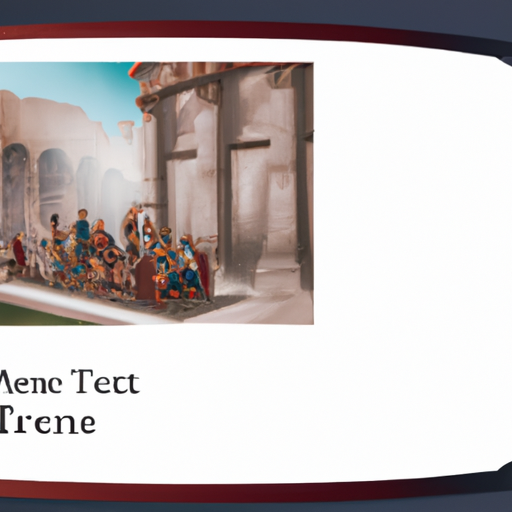Exploring the History of the Biggest Empire in Earth
Unveil the mysteries of time and uncover the grandest dominion that has ever existed in all of creation. Unearth a realm so vast, so powerful, that it left an indelible mark on the annals of history. Embark on a journey through time to explore this ancient empire and its many wonders.

Plunge into a journey of discovery and exploration of one of the most powerful empires in existence. Unearth its secrets and marvel at its grandeur. Uncover the many wonders that have made an eternal impression on history. From its origin to its demise, this ancient realm has left a permanent stamp on the records of time. Follow its evolution through the ages and uncover the enigmas it harbors. Trace the steps of those who lived within its limits and feel first-hand what life was like in this once-mighty kingdom. Let us take you back in time to explore the history of this remarkable empire.
.
Introduction

In a bewildering display of power, the mightiest reign ever known to mankind spanned from a period of 1206 to 1368. Without uttering its name, the Mongol Empire encompassed an astonishing 33 million square kilometers (12.7 million square miles) and flourished with over 100 million inhabitants. Boasting remarkable military aptitude and administrative expertise, they managed to conquer some of the most renowned cities around the world. This expansive realm included present-day Mongolia, Iraq, Iran, Turkey, Kazakhstan, China, Kyrgyzstan, Georgia and Azerbaijan.
– History of the Largest Empires in World History
The study of the most expansive empires in history has been a source of intrigue for many, from historians to the average person. From the Akkadian Empire of Mesopotamia, to the Mongol Empire, these realms have had an indelible effect on our current world.
The Akkadians were the first empire recorded in history and lasted from 2300-2150 BC. Led by Sargon of Akkad, it eventually succumbed to internal strife and external invasions.
Next was the Persian Empire, under Cyrus the Great and Darius I from 550-330 BC. It was one of the largest empires ever created, spanning India to Egypt before being defeated by Alexander the Great. Its influence remains visible in western Asia and northern Africa today.
Rome came onto the scene around 27 BC and lasted until 476 AD when it was overcome by barbarian invasions. At its peak it dominated much of Europe as well as parts of North Africa and Asia Minor – its language, architecture, literature and law codes still linger in Western culture today.
The Mongol Empire was founded by Genghis Khan in 1206 AD; it stretched from China into Eastern Europe before being divided up after his death in 1227 AD. The Mongols left a lasting mark with their art, literature, language, religion and military tactics which were adopted by other cultures across Eurasia.
Finally there is Britain’s reign that began during 1600s-1800s AD under Queen Elizabeth I and later King George III; at its peak it encompassed much of North America as well as parts of Asia and Africa before declining during World War II as colonies gained independence or were taken over by other forces such as Japan or Germany. Its legacy can still be seen through English language, common law systems, democracy models and sporting culture throughout former British colonies worldwide.
These are just some examples of how these great empires have shaped our modern world today!
– Exploring the Political and Social Structures of the Biggest Empires
The study of bygone eras is fundamental to comprehending the political and social structures of some of the world’s most powerful empires. From ancient civilizations to contemporary societies, empires have had a major influence on our world. Examining their political and social systems can give us a clearer view into how these empires progressed and developed through time.
The Roman Empire was an especially influential empire, with its extensive network of roads and aqueducts connecting regions across Europe and North Africa. Its government was headed by an emperor who held absolute power over all aspects of life within the empire, from military decisions to economic policy. The Roman Senate was responsible for giving advice to the emperor concerning matters related to their rule.
The Persian Empire was another significant empire in history, extending from Egypt to India at its peak. Established by Cyrus II in 550 BCE, it lasted until Alexander the Great defeated it in 330 BCE. It had a complex bureaucratic system that enabled effective administration across its wide-reaching territories; this included provinces managed by governors chosen by the central government as well as local councils responsible for local issues such as taxation and law enforcement.
The Ottoman Empire endured for centuries, lasting from 1299 CE until 1922 CE when it collapsed after World War I. This empire had a strong religious element; Islam became its official religion in 1517 CE and Sharia Law became an integral part of its legal system during this period. Politically, it followed a centralized form of rule with an absolute monarch having complete authority over all aspects of life inside the empire’s boundaries.
Exploring these examples can help us understand how different forms of government were used throughout history to shape large-scale societies. Knowing how these political and social structures operated gives us useful understanding about how empires rose and fell throughout time – information which is essential for navigating our own societies today.
– Examining the Causes of the Rise and Fall of the Biggest Empires
For centuries, the waxing and waning of the world’s mightiest empires has been a topic of great interest to historians. Various factors can contribute to a realm’s success or failure, such as geography, economics, military strategy, political structure and culture. Exploring these elements can give us an understanding of past superpowers and why some were able to remain in power for extended periods while others quickly crumbled away.
Geography often played a critical role in the destiny of empires. Those with access to valuable resources like gold, copper and timber had a distinct edge over those without them. Additionally, access to waterways enabled easier transportation of goods than landlocked nations. Strategic locations could also be advantageous; for instance, Rome was situated at the heart of Europe which provided protection from invading forces.
Economics was another key factor in the rise or fall of empires. Realms with trade routes and markets had an advantage over those without them. Furthermore, collecting taxes from conquered territories allowed states to fund their armies and build infrastructure such as roads and bridges which helped secure their power base.
Military strategy was also integral in determining whether an empire would succeed or fail. Empires with powerful armies were better able to protect themselves from invasion or rebellion by enemies and could expand their territory through conquest if they had more advanced weaponry and tactics than their opponents.
The political structure of an empire could likewise have a considerable impact on its fate. Highly centralized governments where one ruler makes all decisions usually lasted longer than decentralized systems where multiple rulers competed for control; this is because centralized regimes were usually better able to maintain order within their borders whereas decentralized systems often led to civil unrest between different factions within the same country.
Finally, culture also affected how successful an empire would be over time. Those that embraced cultural diversity tended to last longer than those who attempted to impose a single culture on all citizens; this enabled them to benefit from different skillsets and perspectives which made them more adaptable compared to homogenous societies which often stagnated due lack of innovation or new ideas.
By analyzing these various causes we can gain greater insight into why some empires rose while others fell throughout history; learning from these factors can provide us with useful lessons about how great powers have come into being – and gone – throughout time.
– Assessing the Legacies of the Greatest Empires in History
The past of the universe is filled with grand empires that have left an everlasting impression on mankind. From the ancient Egyptians and Romans to the Mongol Empire and British Empire, these powerful establishments have left a lasting legacy that can still be seen today. To truly comprehend the effect of these empires, it is essential to assess their legacies regarding their political, economic, social, and cultural contributions.
Politically, many of these empires created large-scale governmental systems that are still in use today. The Roman Empire established a form of representative government that is visible in numerous countries around the world. The British Empire too had a profound influence on global politics as it spread its language and laws across its colonies.
Economically, these empires had an immense impact on international trade networks. The Roman Empire developed an extensive system of roads and aqueducts throughout Europe which enabled commerce between cities and provinces. The Mongol Empire was renowned for its expansive trading routes across Asia and Europe which allowed goods to travel freely between different regions. Likewise, the British Empire set up trading posts throughout its colonies which helped facilitate business between them and other nations worldwide.
Socially, many of these empires presented new customs and beliefs into various societies. The Romans were known for their artistry and literature which circulated through Europe during their reign. Similarly, the Mongols brought fresh ideas about religion to Central Asia while the British introduced concepts such as individualism into their colonies.
Culturally speaking, these empires also left behind an impressive array of monuments and artifacts that can still be observed today. From massive walls built by Chinese Empires to Stonehenge erected by Celts in Britain; from Angkor Wat constructed by Khmer Empires in Cambodia to Machu Picchu made by Inca civilization in Peru; each empire has left a unique mark that continues to captivate scholars and sightseers alike.
To sum up, assessing the legacies of some of history’s greatest empires provides us with insight into how they formed our present world politically, economically, socially, and culturally. It is clear that each empire had a deep influence on society in its own way which continues to be felt even centuries after their fall.
– Evaluating How Technology Shaped the Expansion of Earth’s Largest Empires
Throughout the ages, empires have extended their reach and influence with the aid of technological advances. From the Roman Empire to the British Empire, technology has been a key factor in their success. Innovations such as new weapons and transportation methods, communication systems, and improved agriculture have allowed these powerful empires to expand.
The Romans were among the first to make use of technology for expansion. Their engineering techniques enabled them to build roads and aqueducts, while military technology such as catapults and siege engines helped them conquer new territories. Cavalry tactics also gave them greater speed and agility in battle.
The British Empire was another example of how technology could be used for growth. Steamships revolutionized maritime trade, while telegraphs allowed Britain to stay connected with its colonies across the globe. Railroads provided efficient transportation for goods and people alike, while improvements in agriculture meant that more food could be produced than ever before – helping fuel population growth and economic prosperity during this period.
It is evident that technological advances have had an immense impact on Earth’s largest empires throughout history – enabling them to become some of the most powerful entities on Earth at that time.
conclusion

An empire of unparalleled size, it is thought to be the largest that has ever graced the Earth. Starting in 1206 under the rule of Genghis Khan, its borders eventually sprawled to encompass a staggering nine million square miles at its peak. Such an expansive force left an indelible mark on global trade and cultural exchange, making it one of history’s most potent powers.
.
Some questions with answers
Q1. What was the biggest empire in Earth’s history?
A1. The British Empire was the largest empire in Earth’s history.
Q2. How large was the British Empire?
A2. At its peak, the British Empire covered over 13 million square miles, making it the largest empire ever seen.
Q3. When did the British Empire reach its peak size?
A3. The British Empire reached its peak size in 1922 when it included territories from every continent except Antarctica.
Q4. Who ruled the British Empire?
A4. The British monarch was the head of state for all territories within the British Empire and had absolute power over them.
Q5. What countries were part of the British Empire?
A5. Countries that were part of the British Empire at one time or another include Canada, India, Australia, New Zealand, South Africa, and many more across Asia, Africa, and North America.



